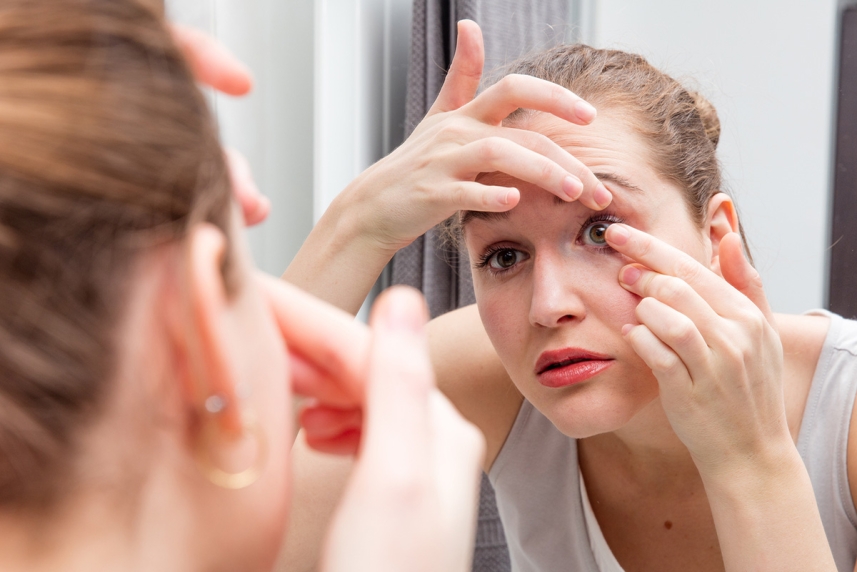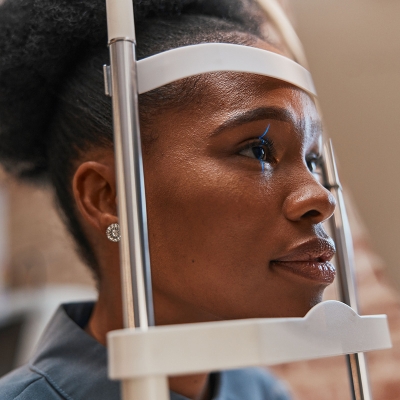What’s the difference between eyeglasses and contact lens prescriptions?
People who wear glasses and contacts need 2 different prescriptions. Find out why, as well as what questions to ask to get the right kind of eyewear.

Eyeglasses and contact lenses both correct vision issues. Many people wear both, switching from one to the other. Some people may prefer to wear contact lenses while at the gym, for instance, then they may use their eyeglasses while they’re at work.
As people go from glasses to contact lenses, they don’t tend to notice a change between the 2 prescriptions. But there are some differences, notes Ronald L. Benner, O.D., an optometrist and president of the American Optometric Association. “Prescriptions for contact lenses and glasses may be similar, but they aren’t interchangeable,” he explains. Both prescriptions will correct a person’s specific vision issue, whether the person may be nearsighted (objects appear blurry far away), farsighted (objects appear blurry up close) or has astigmatism (objects appear blurry near or far away).
Still, you can’t take an eyeglasses prescription and use it to order contact lenses. The same is true for a contact lens prescription.
The reason? Contact lenses are positioned differently over the eye. That affects exactly what the eye care provider may measure. Plus, says Dr. Benner, “a contact lens prescription has additional specifications that are not included with an eyeglasses prescription.”
Learn about the differences between the 2 prescriptions, and how it may affect the way someone sees clearly.
Your contacts and glasses may have different prescriptions, but you can find them both in the same convenient location. Shop now.
How might an eyeglasses prescription be completed?
An eyeglasses prescription has different columns for the OD, or right eye, and OS, or left eye. The other measurements include:1
- The SPH, which is measured in numbers with a plus or minus sign. A minus sign refers to how nearsighted a person may be — or how much their distance vision may need to be corrected. A plus sign indicates how farsighted the person may be — or how much their close-up vision may need to be corrected.
- The CYL, which measures astigmatism. When people have corneas that are more oval shaped than round, their vision may be blurrier.2
- The ADD, which means a person needs additional lens power. For example, if someone is both nearsighted and has a need for reading correction, they may get bifocals.
Eye care providers may consider the material of the lenses too, notes Dr. Benner. “Lenses come in various materials, such as traditional plastic, and thinner, lighter materials. There are also different coatings available, such as nonglare coatings,” he says. All this may be noted in the prescription.
For more information on lens options, download this helpful guide.
How might a contact lens prescription be completed?
Getting a prescription for contact lenses may be more involved, says Dr. Benner. “It’s more than simply knowing the optical power that corrects for nearsightedness, farsightedness or astigmatism.”
That’s why people need a comprehensive eye exam and fitting when they get contact lenses. The exam will probably be longer and require more follow-ups too.3 Here’s why:
The way the contact lens sits on the eye may be important. Eyeglasses are designed to be worn on your face. For that reason, “there is a space between the patient’s eyes and the lenses that they look through,” says Mile Brujic, O.D. He’s an optometrist with the Premier Vision Group in Bowling Green, Ohio.
That space between the front of the eye, or cornea, and the back of the glasses lens is called the vertex distance. It may affect the magnifying power of the lens. Moving the lens farther away or closer may influence how clearly the person can see, explains Dr. Brujic.
“But contact lenses are worn directly on the eye,” he says. “So, it’s key to make sure the lens is interacting with the cornea and the eyelids in a healthy manner.” If the contact lenses aren’t interacting properly, a person may not see well. Worse, they may be prone to infections or dry eyes, especially if people do not handle their contact lenses safely.4
There are different brands of contact lenses. A prescription for eyeglasses may not be brand specific. People may take that prescription and get their eyeglasses from their eye care provider, or they may shop online.
That may not be the case with contact lenses. “Different manufacturers, like Acuvue and Bausch + Lomb, produce their own designs and use their own materials to create lens types for the best comfort and fit,” says Dr. Brujic.
The different materials may include:3, 5
- Rigid gas-permeable lenses. These smaller, harder contact lenses may correct nearsightedness or farsightedness. They are especially good for people with astigmatism.
- Soft contact lenses. These are made of a softer, more flexible plastic. People may get disposable lenses that are replaced every day. Or they may get disposables that need to be replaced every week or every month.
- Hybrid lenses. “This type is a combination of a rigid lens at the center surrounded by a soft skirt or edge,” says Dr. Brujic.
“Oftentimes, each company is attempting to create a lens that provides the best comfort, optics and fit with the material that they produce the lens from,” Dr. Brujic explains.
The size of the contact lenses matters. The material that contact lenses are made of may affect how comfortable they are. But how large or small they may be does too. To determine the perfect size, an eye care provider may look at 2 factors — diameter and base curve.
“The lens diameter measures how large it is. Some people perform better with a bigger lens,” says Dr. Brujic. “One condition that impacts lens size is astigmatism — the lens for this person should be larger, so it’s less apt to rotate while on the eye,” explains Dr. Brujic.
The base curve may affect the fit too. “The base curve is really the curve of the back of the lens,” says Dr. Brujic. How deep or shallow the curve is may depend on the person’s cornea shape. “We are always trying to fit contact lenses to best match the curve of the cornea,” he adds.
In the end, getting the right contact lenses may be a matter of trial and error. This may be one reason why contact lens fittings may take more time. The eye care provider may be trying to make sure the quality of vision and comfort is right.6
Whether people wear glasses, contacts or both, it’s important that they schedule an eye exam every year. “Your prescription may need adjustments that only this appointment can uncover,” says Dr. Benner.
Need new glasses? In 3 easy steps, you could have a new pair on the way. Check your vision coverage, select your favorite frames, then check out. Done!
Sources:
- How to read an eyeglasses prescription American Academy of Ophthalmology, April 2023.
- What is astigmatism? American Academy of Ophthalmology, November 2023.
- Types of contact lenses American Optometric Association.
- Other complications Centers for Disease Control and Prevention, last updated January 2022.
- Contact lenses for vision correction American Academy of Ophthalmology, May 2023.
- Contact lens types Centers for Disease Control and Prevention, last updated January 2022.


